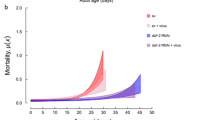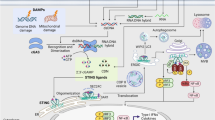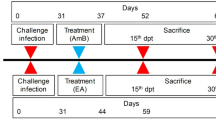Abstract
Programmed cell death (PCD) has important implications in the biology of unicellular parasites, especially in devising control strategies against them. In this study, we examined the role of metacaspase LdMC1 and heat shock protein Hsp70 in Leishmania donovani through transient gene knockdown using antisense oligonucleotides (ASOs), during MG132-induced PCD. Proteasome inhibitor MG132 was used for inducing PCD in the in vitro culture of Leishmania donovani, which was confirmed by morphological and molecular markers. To assess the role of LdMC1 and Hsp70, ASOs with partially modified phosphorothioate backbone were designed against the protein-coding regions of these genes. Promastigotes and axenic ALFs were exposed to ASOs, and gene knockdown was confirmed using RT-PCR. Exposure to MG132 and ASOs led to morphological defects, DNA fragmentation, delay in progressing through the S-phase of cell-cycle and a decrease in the mitochondrial membrane potential. Antisense knockdown of both these genes, individually as well as together, caused phenotypic and molecular characteristics of PCD. Simultaneous knockdown of both LdMC1 and Hsp70 led to a severity in these defects. Parasites co-exposed to MG132 along with ASOs suffered the maximum damage. Together, these data suggest that LdMC1 and Hsp70 have an indispensable role in Leishmania cell-cycle and are, therefore, important for its survival.











Similar content being viewed by others
References
World Health Organization (2004) TDR Summary Report 2004–05
Ready PD (2010) Leishmaniasis emergence in Europe. Euro Surveill 15:19505
World Health Organization (2002) Weekly epidemiological record. 77:365–370
Hotez PJ, Molyneux DH, Fenwick A, Ottesen E, Sachs SE, Sachs JD (2006) Incorporating a rapid-impact package for neglected tropical diseases with programs for HIV/AIDS, tuberculosis, and malaria. PLoS Med 3:e102
Hotez PJ, Molyneux DH, Fenwick A, Kumaresan J, Sachs SE, Sachs JD, Savioli L (2007) Control of neglected tropical diseases. N Engl J Med 357:1018–1027
Beverly SM (2002) Protozomics: trypanosomatid parasite genetics comes of age. Nat Rev Genet 4:11–19
Kedzierski L, Zhu Y, Handman E (2006) Leishmania vaccines: progress and problems. Parasitology 133(Suppl):S87–S112
van Griensven J, Balasegaram M, Meheus F, Alvar J, Lynen L, Boelaert M (2010) Combination therapy for visceral leishmaniasis. Lancet Infect Dis 10:184–194
Murray HW, Berman JD, Davies CR, Saravia NG (2005) Advances in leishmaniasis. Lancet 366:1561–1577
Chakravarty J, Sundar S (2010) Drug resistance in leishmaniasis. J Glob Infect Dis 2:167–176
Ivens AC, Peacock C, Worthey EA, Murphy L, Aggarwal G, Berriman M, Sisk E, Hertz-Fowler C et al (2005) The genome of the kinetoplastid parasite, Leishmania major. Science 309:436–442
Bates PA, Rogers ME (2004) New insights into the developmental biology and transmission mechanisms of Leishmania. Curr Mol Med 4:601–609
Bates PA (2007) Transmission of Leishmania metacyclic promastigotes by phlebotomine sand flies. Int J Parasitol 37:1097–1106
Raina P, Kaur S (2006) Chronic heat-shock treatment driven differentiation induces apoptosis in Leishmania donovani. Mol Cell Biochem 289:83–90
Shaha C (2006) Apoptosis in Leishmania species & its relevance to disease pathogenesis. Indian J Med Res 123:233–244
Das M, Mukherjee SB, Shaha C (2001) Hydrogen peroxide induces apoptosis-like death in Leishmania donovani promastigotes. J Cell Sci 114:2461–2469
Arnoult D, Akarid K, Grodet A, Petit PX, Estaquier J, Amiesen JC (2002) On the evolution of programmed cell death: apoptosis of the unicellular eukaryote Leishmania major involves cysteine proteinase activation and mitochondrion permeabilisation. Cell Death Differ 9:65–81
Lee N, Bertholet S, Debrabant A, Muller J, Duncan R, Nakhasi HL (2002) Programmed cell death in the unicellular protozoan parasite Leishmania. Cell Death Differ 9:53–64
Madeo F, Herker E, Maldener C, Wissing S, Lächelt S, Herlan M, Fehr M, Lauber K, Sigrist SJ, Wesselborg S, Fröhlich KU (2002) A caspase-related protease regulates apoptosis in yeast. Mol Cell 9:911–917
Weinberger M, Ramachandran L, Feng L, Sharma K, Sun X, Marchetti M, Huberman JA, Burhans WC (2005) Apoptosis in budding yeast caused by defects in initiation of DNA replication. J Cell Sci 118:3543–3553
Sen R, Bandyopadhyay S, Dutta A, Mandal G, Ganguly S, Saha P, Chatterjee M (2008) Artemisinin triggers induction of cell-cycle arrest and apoptosis in Leishmania donovani promastigotes. J Med Microbiol 56:1213–1218
Zangger H, Mottram JC, Fasel N (2002) Cell death in Leishmania induced by stress and differentiation: programmed cell death or necrosis? Cell Death Differ 9:1126–1139
Debrabant A, Lee N, Bertholet S, Duncan R, Nakhasi HL (2003) Programmed cell death in trypanosomatids and other unicellular organisms. Int J Parasitol 33:257–267
Ouaissi A (2003) Apoptosis-like death in trypanosomatids: search for putative pathways and genes involved. Kinetoplastid Biol Dis 2:5
Uren AG, O’Rourke K, Aravind LA, Pisabarro MT, Seshagiri S, Koonin EV, Dixit VM (2000) Identification of paracaspases and metacaspases: two ancient families of caspase-like proteins, one of which plays a key role in MALT lymphoma. Mol Cell 6:961–967
Mottram JC, Helms MJ, Coombs GH, Sajid M (2003) Clan CD cysteine peptidases of parasitic protozoa. Trends Parasitol 19:182–187
Carmona-Gutierrez D, Fröhlich KU, Kroemer G, Madeo F (2010) Metacaspases are caspases. Doubt no more. Cell Death Differ 17:377–378
Lee RE, Puente LG, Kaern M, Megeney LA (2008) A non-death role of the yeast metacaspase: Yca1p alters cell cycle dynamics. PLoS One 3:e2956
Szallies A, Kubata BK, Duszenko M (2002) A metacaspase of Trypanosoma brucei causes loss of respiration competence and clonal death in the yeast Sachharomyces cerevisiae. FEBS Lett 517:144–150
Kosec G, Alvarez VE, Agüero F, S′anchez D, Dolinar M, Turk B, Turk V, Cazzulo JJ (2006) Metacaspases of Trypanosoma cruzi: possible candidates for programmed cell death mediators. Mol Biochem Parasitol 145:18–28
Helms MJ, Ambit A, Appleton P, Tetley L, Coombs GH, Mottram JC (2006) Bloodstream form Trypanosoma brucei depend upon multiple metacaspases associated with RAB11-positive endosomes. J Cell Sci 119:1105–1117
Gonzalez IJ, Desponds C, Schaff C, Mottram JC, Fasel N (2007) Leishmania major metacaspase can replace yeast metacaspase in programmed cell death and has arginine-specific cysteine peptidase activity. Int J Parasitol 37:161–172
Lee N, Gannavaram S, Selvapandiyan A, Debrabant A (2007) Characterization of metacaspases with trypsin-like activity and their putative role in programmed cell death in the protozoan parasite Leishmania. Eukar Cell 6:1745–1757
Ambit A, Fasel N, Coombs GH, Mottram JC (2008) An essential role for the Leishmania major metacaspase in cell cycle progression. Cell Death Differ 15:113–122
Vercammen D, Declercq W, Vandenabeele P, Breusegem FV (2007) Are metacaspases caspases? J Cell Biol 179:375–380
Young JC, Agashe VR, Siegers K, Hartl FU (2004) Pathways of chaperone-mediated protein folding in the cytosol. Nat Rev Mol Cell Biol 5:781–791
Feder ME, Hofmann GE (1999) Heat-shock proteins, molecular chaperones, and the stress response: evolutionary and ecological physiology. Annu Rev Physiol 61:243–282
Samali A, Orrenius S (1998) Heat shock proteins: regulators of stress response and apoptosis. Cell Stress Chaperones 3:228–236
Sreedhar AS, Csermely P (2004) Heat shock proteins in the regulation of apoptosis: new strategies in tumor therapy: a comprehensive review. Pharmacol Ther 101:227–257
Brandau S, Dresel A, Clos J (1995) High constitutive levels of heat-shock proteins in human-pathogenic parasites of the genus Leishmania. Biochem J 310:225–232
Bente M, Harder S, Wiesgigl M, Heukeshoven J, Gelhaus C, Krause E, Clos J, Bruchhaus I (2003) Developmentally induced changes of the proteome in the protozoan parasite Leishmania donovani. Proteomics 3:1811–1829
Paba J, Santana JM, Teixeira ARL, Fontes W, Sousa MV, Ricart CAO (2004) Proteomic analysis of the human pathogen Trypanosoma cruzi. Proteomics 4:1052–1059
Debrabant A, Joshi MB, Pimenta PFP, Dwyer DM (2004) Generation of Leishmania donovani axenic amastigotes: their growth and biological characteristics. Int J Parasitol 34:205–217
Barak E, Amin-Spector S, Gerliak E, Goyard S, Holland N, Zilberstein D (2005) Differentiation of Leishmania donovani in host-free system: analysis of signal perception and response. Mol Biochem Parasitol 141:99–108
Alcolea PJ, Alonso A, Gómez MJ, Sánchez-Gorostiaga A, Moreno-Paz M, González-Pastor E, Toraño A, Parro V, Larraga V (2010) Temperature increase prevails over acidification in gene expression modulation of amastigote differentiation in Leishmania infantum. BMC. Genomics 11:31
McQuisten KA, Peek SA (2007) Identification of sequence motifs significantly associated with antisense activity. BMC Bioinformatics 8:184
Lowry OH, Rosebrough NJ, Farr AL, Randall RJ (1951) Protein measurement with the Folin phenol reagent. J Biol Chem 193:265–275
Riccardi C, Nicoletti I (2006) Analysis of apoptosis by propidium iodide staining and flow cytometry. Nat Protoc 1:1458–1461
Bozhkov PV, Suarez MF, Filonova LH, Daniel G, Zamyatnin AA Jr, Rodriguez-Nieto S, Zhivotovsky B, Smertenko A (2005) Cysteine protease mcII-Pa executes programmed cell death during plant embryogenesis. Proc Natl Acad Sci USA 102:14463–14468
Paugam A, Bulteau AL, Dupoy-Camet J, Creuzet C, Freguet B (2003) Characterization and role of protozoan parasite proteasomes. Trends Parasitol 19:55–59
Silva-Jardim I, Horta MF, Ramalho-Pinto FJ (2004) The Leishmania chagasi proteasome: role in promastigotes growth and amastigotes survival within murine macrophages. Acta Trop 91:121–130
Folgueira C, Carrión J, Moreno J, Saugar JM, Cañavate C, Requena JM (2008) Effects of the disruption of the HSP70-II gene on the growth, morphology, and virulence of Leishmania infantum promastigotes. Int Microbiol 11:81–89
Galluzzi L, Aaronson SA, Abrams J, Alnemri ES, Andrews DW, Baehrecke EH, Bazan NG, Blagosklonny MV et al (2009) Guidelines for the use and interpretation of assays for monitoring cell death in higher eukaryotes. Cell Death Differ 16:1093–1107
Lebedeva I, Stein CA (2001) Antisense oligonucleotides: promise and reality. Annu Rev Pharmacol Toxicol 41:403–419
Chakraborty R, Dasgupta D, Adhya S, Basu MK (1999) Cationic liposome-encapsulated antisense oligonucleotide mediates efficient killing of intracellular Leishmania. Biochem J 340:393–396
Compagno D, Lampe JN, Bourget C, Kutyavin IV, Yurchenko L, Lukhtanov EA, Gorn VV, Gamper HB Jr, Toulmé JJ (1999) Antisense oligonucleotides containing modified bases inhibit in vitro translation of Leishmania amazonensis mRNAs by invading the mini-exon hairpin. J Biol Chem 274:8191–8198
Mishra M, Porter-Kelley JM, Singh PK, Bennett JR, Chaudhuri G (2001) Enhanced activity of antisense phosphorothioate oligos against Leishmania amastigotes: augmented uptake of oligo, ribonuclease H activation, and efficient target intervention under altered growth conditions. Biochem Pharmacol 62:569–580
Chan JHP, Lim S, Wong WSF (2006) Antisense oligonucleotides: from design to therapeutic application. Clin Exp Pharmacol Physiol 33:533–540
Galderisi U, Di Bernardo G, Melone MA, Galano G, Cascino A, Giordano A, Cipollaro M (1999) Antisense inhibitory effect: a comparison between 3 V-partial and full phosphorothioate antisense oligonucleotides. J Cell Biochem 74:31–37
Boye SM, Pradhan AA, Grant RJ, Clarke PB (2002) Evidence for sequence-dependent and reversible nonspecific effects of PS-capped antisense treatment after intracerebral administration. Antisense Nucleic Acid Drug Dev 12:95–102
Bush KT, Goldberg AL, Nigam SK (1997) Proteasome inhibition leads to a heat-shock response, induction of endoplasmic reticulum chaperones, and thermotolerance. J Biol Chem 272:9086–9092
Kuhn DJ, Zeger EL, Orlowski RZ (2006) Proteasome inhibitors and modulators of heat shock protein function. Update Cancer Therapeutics 1:91–116
Beere HM (2005) Death versus survival: functional interaction between the apoptotic and stress-inducible heat shock protein pathways. J Clin Invest 115:2633–2639
Horváth I, Vígh L (2010) Cell biology: Stability in times of stress. Nature 463:436–438
Tatischeff I, Petit PX, Grodet A, Tissier JP, Duband-Goulet I, Ameisen JC (2001) Inhibition of multicellular development switches cell death of Dictyostelium discoideum towards mammalian-like unicellular apoptosis. Eur J Cell Biol 80:428–441
Low CP, Shui G, Liew LP, Buttner S, Madeo F, Dawes IW, Wenk MR, Yang H (2008) Caspase-dependent and independent lipotoxic cell-death pathways in fission yeast. J Cell Sci 121:2671–2684
Roy A, Ganguly A, BoseDasgupta S, Das BB, Pal C, Jaisankar P, Majumder HK (2008) Mitochondria-dependent reactive oxygen species-mediated programmed cell death induced by 3,3′-diindolylmethane through inhibition of F0F1-ATP synthase in unicellular protozoan parasite Leishmania donovani. Mol Pharmacol 74:1292–1307
Akopyants NS, Matlib RS, Bukanova EN, Smeds MR, Brownstein BH, Stormo GD, Beverley SM (2004) Expression profiling using random genomic DNA microarrays identifies differentially expressed genes associated with three major developmental stages of the protozoan parasite Leishmania major. Mol Biochem Parasitol 136:71–86
Sarkar A, Sen R, Saha P, Ganguly S, Mandal G, Chatterjee M (2008) An ethanolic extract of leaves of Piper betle (Paan) Linn mediates its antileishmanial activity via apoptosis. Parasitol Res 102:1249–1255
Brenner D, Mak TW (2009) Mitochondrial cell death effectors. Curr Opin Cell Biol 21:871–877
Don AS, Hogg PJ (2004) Mitochondria as cancer drug targets. Trends Mol Med 10:372–378
Green DR, Kroemer G (1998) The central executioners of apoptosis: caspases or mitochondria? Trends Cell Biol 8:267–271
Green DR, Kroemer G (2004) The pathophysiology of mitochondrial cell death. Science 305:626–629
Kroemer G, Galluzzi L, Brenner C (2007) Mitochondrial membrane permeabilization in cell death. Physiol Rev 87:99–163
Lee RE, Brunette S, Puente LG, Megeney LA (2010) Metacaspase Yca1 is required for clearance of insoluble protein aggregates. Proc Natl Acad Sci USA 107:13348–13353
Enoksson M, Salvesen GS (2010) Metacaspases are not caspases—always doubt. Cell Death Differ 17:1221
Chowdhury I, Tharakan B, Bhat GK (2008) Caspases—an update. Comp Biochem Physiol B Biochem Mol Biol 151:10–27
Bozhkov PV, Smertenko AP, Zhivotovsky B (2010) Aspasing out metacaspases and caspases: proteases of many trades. Sci Signal 3:pe48nbn
Louw CA, Ludewig MH, Mayer J, Blatch GL (2010) The Hsp70 chaperones of the Tritryps are characterized by unusual features and novel members. Parasitol Int 59:497–505
Campos RM, Nascimento M, Ferraz JC, Pereira MM, Rocha PO, Thompson GM, Cysne-Finkelstein L, Figueiredo RC, de Melo Neto OP (2008) Distinct mitochondrial HSP70 homologues conserved in various Leishmania species suggest novel biological functions. Mol Biochem Parasitol 160:157–162
Acknowledgments
PR was supported by Senior Research Fellowship from the Council of Scientific and Industrial Research (CSIR), India. SK is supported in the form of extramural funding by Indian Council of Medical Research (ICMR), India.
Conflict of interest
The authors declare no conflict of interest.
Author information
Authors and Affiliations
Corresponding author
Electronic supplementary material
Below is the link to the electronic supplementary material.
11010_2011_1007_MOESM1_ESM.pdf
ESM 1 Position of designed antisense oligonucleotide on LdMC1 gene. A-On nucleotide sequence, B-on mRNA secondary structure, C-relative location on the mRNA (PDF 503 kb)
11010_2011_1007_MOESM2_ESM.pdf
ESM 2 Position of designed antisense oligonucleotide on Hsp70 gene. A-On Nucleotide sequence, B- On mRNA secondary structure, C-relative location on the mRNA (PDF 543 kb)
Rights and permissions
About this article
Cite this article
Raina, P., Kaur, S. Knockdown of LdMC1 and Hsp70 by antisense oligonucleotides causes cell-cycle defects and programmed cell death in Leishmania donovani . Mol Cell Biochem 359, 135–149 (2012). https://doi.org/10.1007/s11010-011-1007-y
Received:
Accepted:
Published:
Issue Date:
DOI: https://doi.org/10.1007/s11010-011-1007-y




